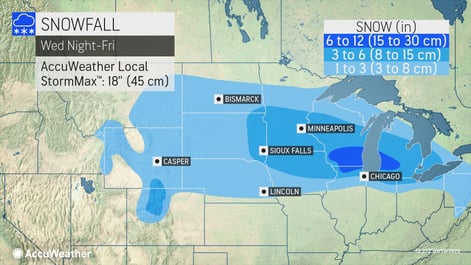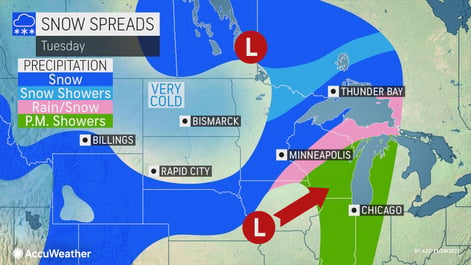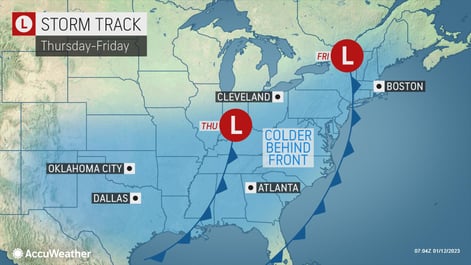Five ways snow and ice can impact students, staff, and disrupt school operations

Summary
Prevent mistakes or missteps when snow and ice are in the forecast with AccuWeather's Snow Warning Service. Here are five ways winter can disrupt school operations, students, and staff.
Key Highlights
School closures are one of heavy snowfall's most immediate and noticeable impacts.
Snow and ice present transportation challenges that can significantly impact students' ability to get to school safely.
Another way schools and students can also be impacted by snow and ice disruptions is through scheduling and curriculum adjustments.
It may still feel like summer, but colder weather is approaching, and before you know it – winter will be here. Now is the time for school districts and officials to start preparing for how the threat of snow and ice can impact the safety of students and staff – not to mention – operations. Here are some ways snow and ice can disrupt school operations and affect students, from closures and virtual days to transportation challenges. AccuWeather’s Snow Warning Service can help you best prepare for winter's challenges.
1. School Closures
School closures are one of heavy snowfall's most immediate and noticeable impacts. When snow accumulates to dangerous levels, schools often have no choice but to close their doors to protect the safety of students and staff. While students may celebrate a snow day, these closures can disrupt educational continuity as teachers scramble to reschedule lessons and assignments. With AccuWeather For Business Snow Warning Service – schools can use the most accurate forecast and advance notice to make the call to cancel or delay classes, minimizing the disruption to the academic calendar and ensuring that safety remains a top priority.
2. Transportation Challenges
Snow and ice present transportation challenges that can significantly impact students' ability to get to school safely. School buses navigating icy roads pose a risk to both students and drivers. Students who rely on public transportation may face delays and cancellations, making it difficult to get to school. Schools should also take into consideration the slip-and-fall risk for students who may walk to school. AccuWeather’s Snow Warning Service offers real-time weather data and road condition updates to transportation authorities and schools. This gives them the confidence to make informed decisions about delaying bus routes or closing schools so students can travel safely.
3. Classroom Disruptions
Even when schools remain open during snow and ice conditions, classroom disruptions are inevitable. Snow-covered shoes and wet clothing can create messy classrooms, while cold temperatures can make learning environments less comfortable. Teachers may have to adjust their lesson plans to accommodate students who arrive late or miss school due to weather-related issues. AccuWeather’s Snow Warning Service can help schools best prepare for such disruptions by receiving advance notice of snowstorms and extreme cold. Schools can proactively plan for classroom changes, allocate additional resources for cleaning, and offer support to students who may miss class.
4. Internet and Remote Learning Challenges
In recent years, the rise of remote learning has added another layer of complexity to snow and ice disruptions. Snow and ice storms can knock out power lines and disrupt internet connectivity, making it challenging for students to participate in virtual classes. As a result, not all students could access reliable internet for remote learning. By knowing in advance about the possible challenges, schools can take proactive steps to provide offline learning materials so that learning can continue even in poor weather conditions.
5. Scheduling and curriculum adjustments
Another way schools and students can also be impacted by snow and ice disruptions is through scheduling and curriculum adjustments. When snow days accumulate, or when there are frequent closures and delays due to winter weather, schools may need to adjust their academic calendars, resulting in extended school years, shortened vacations, and the need to alter the curriculum, all of which impact teachers and students.
Prevent mistakes or missteps on school cancellations, delayed starts, and early dismissals. Protect your students and staff by making the right decisions at the right time with AccuWeather’s Snow Warning Service.
Backed by AccuWeather’s Superior Accuracy™, AccuWeather's Snow Warning Service helps to provide pinpoint weather insights that help you make the most effective, accurate decisions during months with disruptive winter weather. AccuWeather goes beyond just predicting snow; we also detail the actual impacts of snow. For example, will roads be mainly wet or snow-covered? Will lingering moisture or snow on the road refreeze as the afternoon progresses? We give you the information you need to make the right call.
Benefits of AccuWeather’s Snow Warning Service:
- Precise weather event start and end times
- More accurate total expected snow and ice accumulations
- Specific changeover times for snow, ice, and rain
- Hourly temperatures and wind conditions before, during, and after the storm
- Most effective communication of pending risk
- Post-storm weather conditions, including verified precipitation amounts
Questions? AccuWeather’s expert meteorologists are available 24/7, 365 days a year, for one-on-one consultations.








